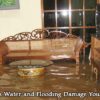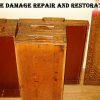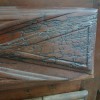Whether caused by a spring thaw, heavy rainfall, or hurricane, flooding can be devastating – just a couple of inches of water can lead to thousands of dollars of property damage, not to mention the risks to people’s lives and health.

Flooding wreaks havoc in its path.
Even if you have the time to get yourself and your family to safety when flooding occurs, there will be little you can do to protect your property and your belongings. Most likely, your home and everything in it will be submerged in water and badly damaged – or completely destroyed.
Yet, if the water recedes quickly and you take prompt and adequate measures to stop the spread of the damage, it may be possible to rescue most of your possessions. And since furniture pieces are among the most valuable items in a house, you will probably want to salvage as many of them as possible.
Whether your furniture can be saved after a flood depends on the type of furniture you have and the extent of the damage it suffered. Water can saturate upholstery, cause wood to rot and warp, and allow mold to develop. The flood damage will get progressively worse until the piece is completely dried out and properly treated.
So, to be able to save your water-damaged furniture, you need to know what kind of damage to look for and how to fix it quickly.
How Does Water Damage Furniture
Excess moisture can damage furniture in many ways – it penetrates the porous wood and upholstery materials and causes changes in the structure and appearance of a piece.
The most common effects of water damage on furniture include:
- Water stains – Dampness causes wood furniture to “blush” – the finish gets hazy and white spots develop on the surface;
- Loose veneer – Veneered furniture usually has a core made of plywood, particleboard, or medium-density fiberboard. When they come in contact with water, these low-quality core materials swell. As a result, the veneer seams come apart and the veneer gets loose;
- Falling apart – Water may loosen joints and ruin the glue holding different furniture parts together, causing the piece to weaken and fall apart;
- Cracking – Saturated wood expands and then shrinks as it dries, causing splits and cracks to form in the wood;
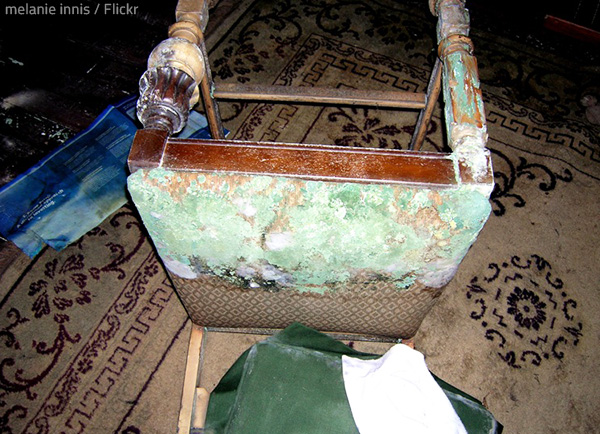
Furniture can be badly damaged (or completely destroyed) by flood waters.
- Warping – When the moisture content of different parts of a piece of wood changes unevenly – such as when one part of a wood furniture item dries faster than the rest of it – the wood warps (deviates from flatness). The part that dries more quickly shrinks faster and causes stress that changes the shape of the wood – it can bow, cup, crook, or twist;
- Rotting – When the moisture content of the wood increases to above 30%, a certain type of fungi (lignicolous fungi) takes root in the moist wood surface and secrete enzymes that break down the wood cells, causing the wood to decay;
- Mold growth – Both wood and upholstery provide an ample organic food source for mold spores, so as soon as there is enough moisture, mold begins to grow on the furniture surface. The longer the water sinks into the wood, the greater the chances of mold developing on the furniture and spreading throughout your home.
The damage to your furniture can progress from slight to severe in only a few days, so you need to take quick and efficient measures to dry out and fix your cherished pieces immediately after the disaster.
How to Repair Water Damaged Furniture
As already mentioned, to be able to salvage water-damaged furniture, you need to act quickly – the more time has passed after a flood, the greater the damage will be.
When it is safe to return to your home after a flood, make sure you bring a camera with you and photograph all the damage – you will need the records for your insurance claim. Then, inspect the house and its contents and take any salvageable pieces to a dry area.
The worst damage comes from prolonged exposure or submersion in water, so you need to get your furniture out of or away from the water as quickly as possible. If a furniture item is too heavy to move, place wood blocks under its legs to keep the piece away from the wet floor. It is also a good idea to put aluminum foil under the wooden blocks to prevent them from getting saturated and transferring moisture to your furniture.
Your next step is to decide what to do with your water-damaged furniture.
How to Determine Which Pieces Are Worth Restoring
There are several important factors to consider when trying to salvage your furniture after a flood:
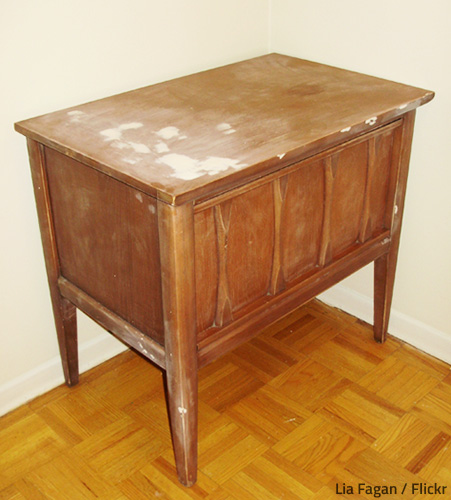
To be restored or not to be restored, that’s the question.
- The extent of the damage – If your furniture has been in contact with water for a short time and sustained only minor damage, chances are it can be easily saved – if promptly and properly treated. If the furniture has been submerged in water for more than two or three days and already begun to rot or warp, it is likely beyond repair;
- The category of water damage – Furniture that has been soaked with black water swarming with hazardous contaminants (category 3 water damage) cannot be effectively cleaned and restored and should be thrown out. Furniture that has been affected by category 2 water damage (grey water from malfunctioning appliances) should be thoroughly cleaned and disinfected before any restoration attempts are made. Furniture that has been in contact with clean water (category 1) can be easily salvaged unless it has stayed underwater for too long;
- The type of furniture – Solid wood furniture has a better chance of being fully restored after a flood than upholstered or particle board furniture because wood is less porous and usually protected with a finish, which makes it more difficult for water to damage the furniture. Upholstered furniture, however, should almost always be tossed, as the upholstery absorbs the harmful contaminants from the floodwater. Veneered furniture is permanently damaged by excess moisture and cannot be saved;
- The value of the furniture – Quality furniture, antiques, and vintage pieces are usually worth the time, effort, and expense of restoration. You will also probably want to keep and repair furniture that has high sentimental value – such as a family heirloom, for example – no matter how severe the damage;
- The restoration cost – Last but not least, you need to consider the cost of restoring your furniture and compare it to the cost of replacing the item with one of similar quality. The cost analysis will help you determine if it’s more cost-effective to replace a damaged furniture piece instead of restoring it.
How to Dry Wet Furniture
Proper drying is of paramount importance for saving water-damaged furniture. You need to clean and dry your pieces well before you can attempt to repair the damage.
The best way for furniture to dry is slowly and steadily:
- Take your wet furniture outside and hose off any mud, dirt, and debris. Wash the piece with a solution of mild soap and water, then rinse with clear water. Remove excess water by blotting or wiping the surfaces with towels and clean rags. If mildew has already appeared, use mineral spirits on the affected areas (be sure to check underneath and inside the furniture);
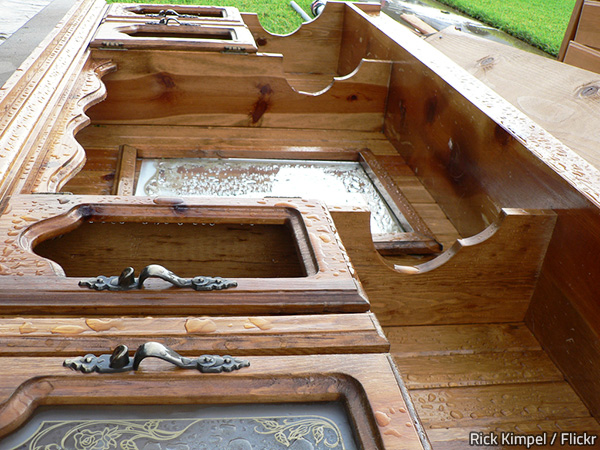
Water-damaged furniture must be properly cleaned and dried before it can be repaired.
- Remove doors, drawers, back panels, and any other furniture parts that can be easily disassembled to allow air to circulate throughout the piece and expedite drying. (Drawers and doors may be stuck as excess moisture causes wood to expand. If this is the case, don’t try to force them out – wait until the furniture has dried a bit and the wood has begun to shrink. Check the piece periodically and remove drawers and doors as soon as you can without forcing them.);
- Remove upholstery fabrics (if possible) and dry them separately (see below for details on how to treat water damaged upholstery);
- Take the furniture to a shaded, well-ventilated area. Do not let it dry in the sun as the heat will cause the wood to dry too quickly and too unevenly – which may lead to warping and twisting out of shape;
- Use fans and blowers to ensure better air circulation. If possible, move either the air-moving devices or the furniture to different positions so all furniture parts get exposed to dry, moving air. If you’re drying your damaged furniture indoors, use dehumidifiers to keep the area as dry as possible;
- Refrain from using heating devices like propane heaters or hair dryers to speed up the process as this may cause the wood to warp and result in more long-term damage.
Keep in mind that it may take several weeks before the furniture is completely dry and ready to be repaired.
How to Clean Water-Damaged Upholstery
Upholstered furniture can sometimes be salvaged, but in most cases, it will be a total loss, especially if it was saturated with black water.
# If your upholstered pieces did not sit in water for too long and came in contact with only clean water during the flooding, they can be easily saved:
- Separate the upholstery fabrics, upholstery cushions, and other colored items to prevent color bleeding;
- Wash the upholstery with hot water and appropriate cleaning agents;
- Dry it completely as soon as possible to prevent mold from forming.
# If your upholstered furniture has been submerged in water for a long time, the upholstery must be removed entirely and cleaned, dried, and treated separately.
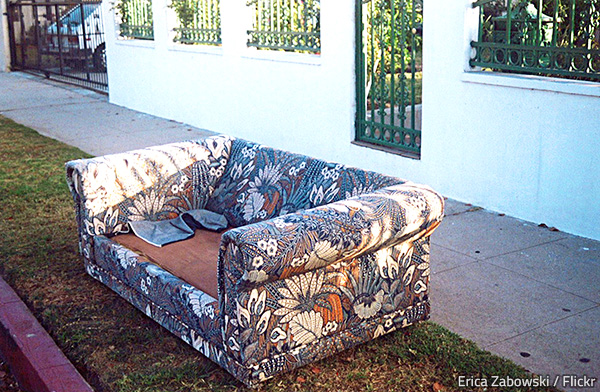
Restoring soaked upholstered furniture can be quite tricky.
# Upholstered pieces that have been in contact with grey water must be pressure treated with very high temperature water that kills any bacteria and other pathogens present. Then, the furniture must be properly dried. It is best to place the upholstered pieces in a room where air movers and a dehumidifier can be set up. The air movers should be positioned in such a way that they pass hot, dry air over and through the furniture. The moisture evaporating from the wet upholstery has to be captured by an industrial-strength dehumidifier.
# Upholstered furniture that has been soaked in category 3 floodwater is usually not worth saving – the upholstery material is porous and easily absorbs contaminants. Removing them is very difficult, so in most cases, flood-soaked upholstered furniture should be thrown away. If it is a very valuable piece – an antique or a family heirloom with high sentimental value – you want to keep, contact an experienced disaster furniture restoration specialist for advice.
Good to remember: Heavily soaked upholstered furniture should always be treated by a professional – the restoration process is difficult and can be fairly expensive, since it may involve stripping the piece down to its frame and reupholstering the furniture. Even the springs and webbing may have to be replaced, depending on the extent of the water damage. Only top-quality professional disaster furniture restoration services can ensure the success of the project.
How to Fix Water-Damaged Wood Furniture
Wood furniture has a good chance of being salvaged after a flood, especially if it hasn’t been sitting in water for too long. Lower-quality furniture made from manufactured products like particleboard, plywood, or fiberboard may be total losses, but solid wood furniture is more resistant to water damage and can usually be saved and fully restored.
The first step is to thoroughly clean and dry your wet wood furniture. Make sure the wood is completely dry before you begin repairing the piece – moisture in wood furniture can easily result in mold growth, so proper drying is crucial. Also, be careful to keep your wood furniture out of direct sunlight and ensure even drying to avoid warping and cracking.
Once the furniture is fully dry, assess the damage and take the necessary measures to fix your pieces. Solid wood furniture with white spots, flaking or missing finish, loose joints, small cracks, and even warped boards can be salvaged:
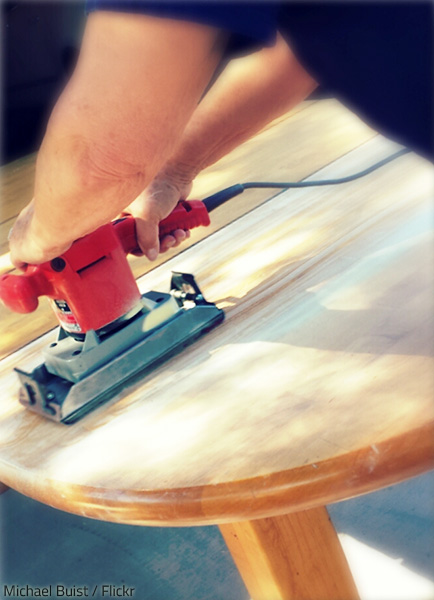
Water damaged wood furniture may need to be refinished.
- White spots can be cleaned with turpentine or a mixture of equal parts ammonia and water. Rub the affected areas with a damp cloth dipped in the cleaning solution and wipe dry. If the color is not restored, dip 000 steel wool in olive oil or lemon oil and rub slightly along the wood grain. Wipe down with a soft cloth. Once the color has been restored, polish the wood surface with wax or furniture polish. (If spots remain after all efforts to remove them, the piece should be stripped of the old finish and refinished.);
- Lightly damaged finish can be restored with cream wood restorers;
- More severely damaged finish must be stripped and the furniture piece sanded and refinished;
- Loose joints and veneers that are loose only in a few places can be re-glued;
- Furniture parts that have fallen apart can be put back on, after they have been cleaned and dried;
- Warped boards can be straightened or replaced.
Restoring water-damaged wood furniture is a time-consuming and labor-intensive process that requires special tools and expert skills – you can treat white spots and lightly blemished finish yourself, but repairing more severely damaged pieces is better left to the professionals. The specialists have the advanced equipment and technical know-how to restore your furniture to its original condition. Most importantly, they have rich experience in dealing with water-damaged furniture and know what restoration methods and techniques will work best in your case. The pros will not only fix your furniture but will also preserve its value. Improper drying and repair procedures, on the other hand, can cause more long-term damage to a piece.
So, make sure you secure the services of a qualified and competent disaster furniture restoration company for your project. Call a reputable furniture repair craftsman immediately after the flood (in any case of water damage, the sooner treatment begins, the greater the chances for success), ask them to provide a written estimate for repairing the damage (you will need it for your insurance claim), and let the pros do their job – your furniture will be as good as new.








